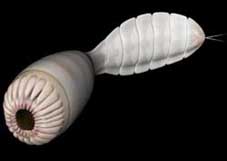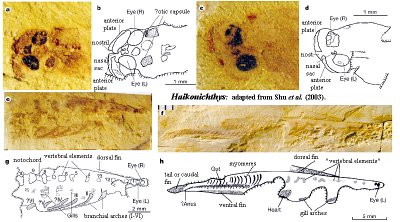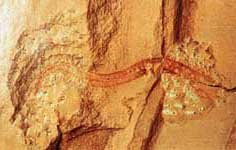Saturday, July 01, 2006
Other Early Chinese Fish-like Vertebrates and Pre-Vertebrates
As we go further back in time we encounter ever more ancestral organisms. In China precursors to the fish-like forms discussed in previous posts are found in the early Cambrian Chengjiang deposits from the southern province of Yunnan. A number of important early chordates and their allies have been described from these deposits. The vertebrates, which include mammals, birds, reptiles, amphibians and fish, have their origins within this assemblage. Clear fossils of primitive jawless fish (agnathans) have long been known from the Lower Ordovician Period (~475 million years ago), with more questionable examples from the earlier Cambrian Period (510-545 million years ago). Some of the newly described fossils from Chengjiang have been clearly identified as agnathans, a discovery that pushes back the fossil record of the vertebrates about 50 million years.
The specimens from Chengjiang include (descriptions from Vertebrate section of Palaeos and other sources):
Haikouella - originally thought to be a stem vertebrate, is now regarded as a Vetulicolian or other stem deuterostome. The Deuterostomes (meaning "secondary mouth") are a major animal taxon that includes the echinoderms (e.g., crinoids, starfish, sea urchins) and the chordates (e.g., sea squirts, lancelets, and vertebrates). The deuterostomes belong to a larger group within the Animalia called the Bilateria, owing to their bilateral symmetry along a median axis: note that some deuterostomes (i.e. echinoderms) are bilateral as embryos, later maturing to have radial symmetry. Shu & Conway Morris (2003) have made a point of "emphatically contest[ing] the vertebrate affinities of Haikouella, emphasizing the absence of eyes, notochord, myomeres, or brain.
Examples of Haikouella and a reconstruction of H. jianshanensis. (A, B, and E to J) H. jianshanensis; (C and D) H. lanceolata. All are lateral views, except for (I) and (J). In (A)and (B), the dorsal posterior segments are faintly visible [specimen (226)]. The complete specimen with well-preserved dorsal segments (totaling 10) is shown in (C). A drawing of the anterior of (C) is shown in (D). The anterior with an expanded median zone [specimen (010)] is shown in (E) and (F), and the anterior with a closed median zone [specimen (358)] is shown in (G) and (H). An oblique view [specimen (238)] is given in (I) and (J). (K) A reconstruction of H. jianshanensis. Abbreviations are as follows: sal segments; Du, dorsal unit; Eg, ?epipharyngeal structure; Emz, expanded median zone; Es, esophagus; Exg, external gills; G1 to G6, gill arch 1 to 6; L.Cmz, left closed median zone; L.Du, left dorsal unit; L.g1 to L.g6, left gill arch 1 to left gill arch 6; Ls, left skirt; M, mouth; R.Cmz, right closed median zone; R.Du, right dorsal unit; R.g1 to R.g6, right gill arch 1 to right gill arch 6; Rs, right skirt; S, skirt; Sb, bar of skirt; Sbsb, space between skirt and body; Sg, ?spiral gut; Tmmz, thin membrane covering median zone; Vbv, ventral blood vessels; Vnc, ?ventral nerve cord; and Vu, ventral unit. Scale intervals are in millimeters.
Haikouella and related forms are classified as Yunnanozoans. They branched off the chordate or hemichordate lines very early on and are probably not far removed from the last common ancestor of deuterostomes as the diagram below suggests.
Haikouella must have been an important part of the Chengjiang biota as more than 1400 specimens were studied for the analysis of their characteristics as detailed in the Science article below.
Shu D, Conway Morris S, Zhang ZF, Liu JN, Han J, Chen L, Zhang XL, Yasui K, Li Y (2003) A New Species of Yunnanozoan with Implications for Deuterostome Evolution. Science 299(5611):1380-1384
Yunnanozoon lividum - from the Early Cambrian (about 530 million years ago) of Ma'anshan, Chengjiang, Yunnan, People's Republic of China has been described as the oldest known example of a hemichordate, but see above. The phylum (or 'supergroup') Hemichordata is closely associated with the phylum Chordata, which includes the vertebrates along with other groups such as cephalochordates and urochordates. As with Haikouella, the identification of Yunnanozoon is very significant for understanding the early evolution of chordates and their allies.
Yunnanozoon lividum
Haikouichthys - originally described by Shu et al. (1999) as one of two possible vertebrates on the basis of unique specimens from Chengjiang. The other taxon, Myllokunmingia, remains unique. It has been suggested that Myllokunmingia is the same as Haikouichthys, Hou et al. (2002). The issue of Myllokunmingia's exact characteristics and affinities became somewhat less urgent after five hundred new specimens of Haikouichthys were found near Haikou. Portions of the anatomy were then redescribed on the basis of this massive body of new data by an all-star cast of Chinese and Western early vertebrate specialists, Shu et al. (2002). They at first pronounced Haikouichthys to be not merely a chordate but a lamprey-like jawless fish, with gill bars supporting its gills. Myllokunmingia is said to have pouch-like structures associated with its gills, which also makes it a jawless fish. On the other hand a cladogram by Shu et al. (2003) identifies Haikouichthys as a basal chordate, or possibly a basal craniate, but not a vertebrate. Nevertheless, Haikouichthys has a number of characteristics thought to be derived features shared with true vertebrate. These discoveries emphasize the complexity of early vertebrate origins, but they do not change prevailing ideas about the evolution of fishes from earlier chordates. They do, however, change the timing of these transitions. It's now clear that the origin of vertebrate fishes is very early in the Cambrian. By the same token, the subsequent evolution of the fishes proceded at a much slower pace. It took about 30 m.y. before the cartilaginous structure of the earliest jawless fishes began to change into bone.
For more on early Chinese vertebrates such as Haikouichthys and Myllokunmingia see this article by R. Monastersky from Science News Online.
Cathaymyrus diadexus – also from the Early Cambrian at Ma'anshan, Chengjiang, Yunnan, People's Republic of China, is the oldest known example of a cephalochordate. The form of Cathaymyrus resembles Pikaia from the Middle Cambrian Burgess Shale of Canada, but this animal is about 10 million years older. Some paleontologists have suggested that the vertebrates, evolved from cephalochordates like Cathaymyrus.
Xidazoon stephanus - from the Early Cambrian at Haikou, Kunming, Yunnan, People's Republic of China is more problematic as its relationship to the known animal groups is ambiguous. The anterior of this animal resembles an agnathan fish known as a pipiscid, but the segmented tail-like posterior is more like that of an invertebrate, such as an arthropod. Because of its enigmatic nature, Xidazoon has at present been assigned to the pseudo-phylum "Problematica". Nevertheless, this animal has great importance in the study of the evolution of the primitive deuterostomes and protostomes.

 Xidazoon stephanus
Xidazoon stephanus
Reconstruction is supervised by Prof. Shu Degan.






